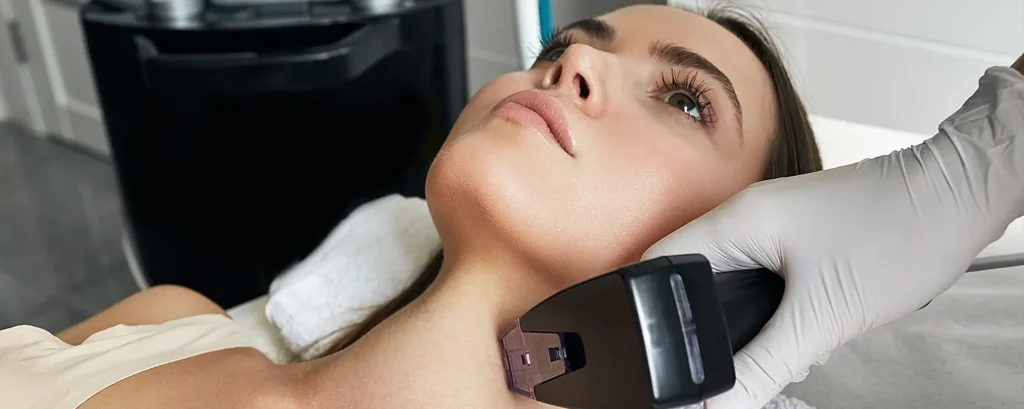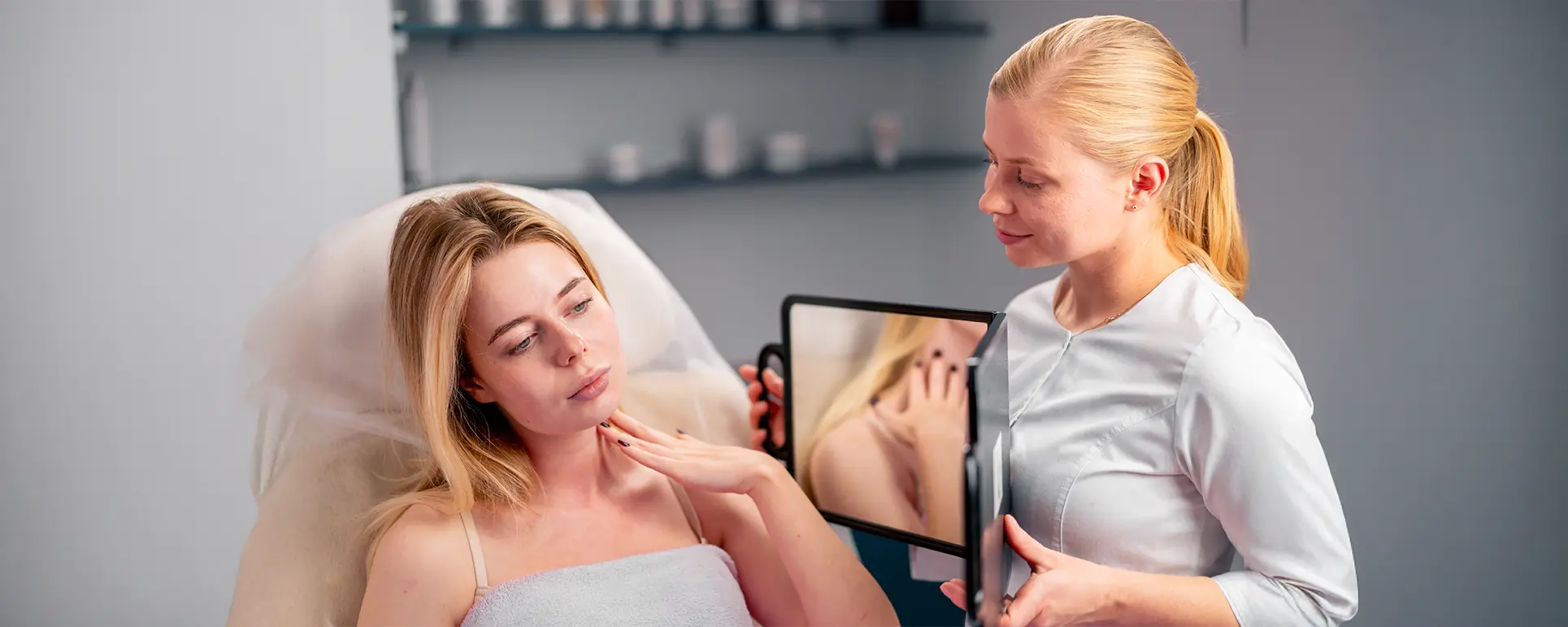You’ve probably noticed it the skin on your neck doesn’t always match the youthful glow of your face. Even if you’ve invested in good skincare, sun protection, or cosmetic treatments for your face, the neck often tells a different story.
It’s one of the most common concerns dermatologists hear: “My face looks great, but why does my neck look older?”
In this article, I’ll explain why neck skin tends to age faster than facial skin, the key biological and environmental factors behind it, and the most effective dermatologist-approved treatments to restore firmness and smoothness. By the end, you’ll know exactly how to treat and prevent premature neck ageing.
Why the Neck Ages Differently

The skin on your neck is not the same as the skin on your face. It’s thinner, more delicate, and often neglected in daily skincare routines. These differences make it more vulnerable to early signs of ageing.
Here’s why the neck tends to age faster:
- Fewer sebaceous glands: The neck produces less natural oil, meaning it’s more prone to dryness and fine lines.
- Constant movement: Looking down at phones and laptops all day can cause “tech neck” horizontal lines and loose skin from repetitive motion.
- Thinner dermal structure: With less collagen and elastin compared to the face, the neck loses firmness more quickly.
- Sun exposure: The neck and décolletage are often exposed but rarely protected, leading to pigmentation and texture changes.
Together, these factors make the neck one of the first areas to reveal your true age sometimes even before your face does.
The Anatomy of Neck Skin
To understand why your neck looks older, it helps to look beneath the surface.
- Epidermis: The outer layer is thinner on the neck, making it more fragile and easily damaged by environmental stress.
- Dermis: This middle layer contains less collagen and elastin compared to facial skin, so it sags faster.
- Subcutaneous layer: Fat distribution in the neck is uneven, which contributes to lines, creases, and a less defined contour over time.
Since the neck has fewer structural supports, once collagen starts to break down usually in your late 20s or early 30s the effects become visible sooner.
Common Signs of Neck Ageing
You might notice one or more of the following changes as the skin on your neck begins to age:
- Horizontal lines (“neck rings”)
- Loose or sagging skin (“turkey neck”)
- Vertical muscle bands (platysmal bands)
- Uneven texture or roughness
- Brown spots and pigmentation
- Loss of sharp jawline definition
These changes often occur gradually, but once visible, they can make your overall appearance look older even if your face still looks youthful.
The Role of Sun Exposure

Sun exposure is one of the most significant causes of premature neck ageing. The skin on your neck and chest is regularly exposed to UV rays, yet most people stop applying sunscreen at the jawline.
UV light breaks down collagen and elastin the proteins that keep your skin smooth and tight. Over time, this leads to:
- Fine lines and wrinkles
- Hyperpigmentation
- Uneven tone and texture
- Sagging or thinning skin
Wearing broad-spectrum SPF 30 or higher daily and extending it to your neck and décolletage is one of the simplest and most effective ways to prevent further ageing.
Tech Neck: Modern Lifestyle Ageing
In today’s digital age, “tech neck” has become a buzzword for a reason. Constantly looking down at phones, laptops, and tablets causes repetitive folding of the skin across the neck.
This mechanical stress leads to horizontal creases and deepening lines even in younger adults. Over time, these lines can become permanent, especially as collagen production declines.
Maintaining better posture, raising your screens to eye level, and doing gentle neck stretches can all help reduce strain on the skin.
The Collagen Connection
Collagen is the scaffolding that keeps your skin smooth and resilient. Unfortunately, it declines naturally with age, dropping by around 1% per year after your mid-20s.
On the neck, where collagen levels are already lower, this loss has an amplified effect resulting in looseness and wrinkles.
Lifestyle factors like smoking, stress, and poor diet can further accelerate collagen breakdown. That’s why collagen-stimulating treatments have become one of the most effective ways to reverse neck ageing at its source.
Environmental and Lifestyle Factors
Aside from UV exposure and digital posture, several lifestyle factors contribute to an ageing neck:
- Dehydration: Makes fine lines more visible.
- Smoking: Reduces oxygen flow to the skin, accelerating sagging.
- Poor nutrition: Lack of vitamins C and E affects collagen synthesis.
- Sleeping positions: Constant side-sleeping can cause creases.
- Neglect in skincare: Many people apply serums or moisturisers to their face but forget the neck entirely.
Taking care of your neck requires a combination of daily habits and targeted treatments to restore balance and resilience.
At-Home Skincare for Neck Ageing
If you’re starting to notice early signs of neck ageing, a consistent at-home routine can help. Here’s what to include:
1. Cleanse Gently
Avoid harsh cleansers that strip moisture. Opt for pH-balanced, hydrating formulas that maintain your skin’s barrier.
2. Exfoliate Once a Week
Gentle exfoliation removes dead cells, improving texture and allowing better product absorption.
3. Moisturise Daily
Use a rich, peptide-infused cream or one containing hyaluronic acid to hydrate and plump the skin.
4. Apply Retinol or Peptides
Retinol increases cell turnover and collagen production, while peptides strengthen the dermal matrix. Start slowly to avoid irritation.
5. Use Sunscreen Every Day
Apply a broad-spectrum SPF 30+ to your neck and chest daily, even in winter or when indoors near windows.
While topical care helps, deeper structural changes often require professional intervention.
Dermatologist-Recommended Treatments
When skincare alone isn’t enough, modern dermatology offers safe, effective treatments that rejuvenate and tighten the neck from within.
1. Radiofrequency Skin Tightening
This non-invasive treatment uses heat to stimulate collagen and elastin production. It helps firm sagging skin and improve tone over time.
Popular systems like Morpheus8 or Thermage are particularly effective for mild to moderate laxity.
2. Ultrasound Lifting (Ultherapy)
Ultrasound energy targets the deeper layers of the skin, promoting collagen synthesis. It’s ideal for patients seeking a subtle lift without downtime.
3. Laser Resurfacing
Fractional CO₂ or erbium lasers smooth wrinkles, reduce pigmentation, and improve texture by resurfacing the top layer of skin while stimulating new collagen growth.
4. Injectable Collagen Stimulators
Treatments like Juläine or Sculptra can boost the skin’s elasticity and firmness by encouraging the body to produce more collagen naturally.
5. Botulinum Toxin (Neck Botox)
Tiny injections can relax platysmal bands (the vertical muscles of the neck), creating a smoother, lifted appearance.
6. Dermal Fillers
Hyaluronic acid fillers can restore volume to hollow or sagging areas, softening deep neck lines.
7. Microneedling with PRP (Platelet-Rich Plasma)
Microneedling triggers collagen production through controlled micro-injuries, while PRP enhances healing with growth factors from your own blood.
These treatments can be combined or tailored to your needs by a qualified cosmetic dermatologist for optimal results.
How Long Do Treatments Take to Work?
The timeline for seeing results really depends on the treatment you choose. If you go for laser resurfacing, you can usually start noticing improvements in about 4–6 weeks, and the effects can last up to 12–18 months. With radiofrequency, results might take a bit longer around 6–8 weeks but you can enjoy smoother skin for over a year.
If you opt for Ultherapy, expect to see changes in roughly three months, with results lasting up to two years. Collagen stimulators, like Juläine, tend to show their magic between 6–12 weeks, and the benefits can stick around for up to 18 months. For quicker fixes, Botox works within 1–2 weeks but usually needs topping up every 3–6 months, while dermal fillers give almost immediate results, lasting anywhere from 6–12 months depending on the type.
Often, the best outcomes come from combining treatments, because this approach tackles both surface concerns and deeper structural ageing, giving you a natural, long-lasting look.
Prevention: Protecting Your Neck at Every Age
While treatments can reverse signs of ageing, prevention is always better than cure. Here’s how to maintain a youthful neck long-term:
- Extend your skincare: Whatever you use on your face cleanser, serum, SPF apply it to your neck too.
- Mind your posture: Keep your screen at eye level to avoid creasing.
- Stay hydrated: Both inside and out.
- Eat for collagen: Include vitamin-rich foods such as berries, citrus fruits, and leafy greens.
- Avoid harsh perfumes: Some fragrances contain alcohols that dry and irritate neck skin.
- Sleep smart: Try sleeping on your back to reduce compression lines.
Simple daily habits can make a visible difference over time.
Are Neck Treatments Painful?
Most modern rejuvenation procedures are minimally invasive and well-tolerated.
- Radiofrequency and ultrasound treatments cause mild warmth but no significant discomfort.
- Laser sessions may involve brief tingling or heat sensations, managed with topical anaesthetic.
- Injectables such as collagen stimulators or fillers are performed with fine needles, and local numbing ensures comfort.
Downtime varies from no recovery for Botox or radiofrequency, to a few days of redness for laser resurfacing.
Can You Combine Neck and Face Treatments?
Absolutely and in fact, it’s often recommended. Treating the face and neck together ensures harmony and avoids an uneven look.
For example:
- Laser resurfacing can smooth both face and neck simultaneously.
- Collagen stimulators restore firmness in both areas.
- Ultherapy can lift the lower face and neck together for a cohesive result.
Your dermatologist will design a treatment plan that blends procedures safely and effectively for your unique skin type.
Myths About Neck Ageing
Let’s clear up a few common misconceptions:
- Myth 1: Only older people get neck wrinkles.
Reality: “Tech neck” can appear even in your 20s due to repetitive screen use. - Myth 2: You can fix sagging skin with creams alone.
Reality: Topical products help, but structural tightening often needs medical treatments. - Myth 3: Surgery is the only effective option.
Reality: Modern non-surgical methods offer excellent results with little or no downtime. - Myth 4: Sunscreen isn’t needed on cloudy days.
Reality: Up to 80% of UV rays penetrate clouds and windows, so protection is essential every day.
Realistic Expectations
While aesthetic treatments can dramatically rejuvenate the neck, it’s important to have realistic expectations. No non-surgical option can replicate the exact effect of a surgical neck lift, but they can achieve visible, natural-looking improvement without downtime or scarring.
Your dermatologist will assess your skin’s condition, laxity, and overall goals before recommending the best approach.
FAQs About Neck Ageing and Treatments:
1. Why does my neck show signs of ageing before my face?
Your neck tends to age faster because the skin there is thinner and more delicate than facial skin. It has fewer oil glands, less collagen, and less elastin, which are crucial for maintaining firmness. Daily habits, like looking down at your phone or laptop, also cause repetitive folds, commonly known as “tech neck.” Add sun exposure and often neglected skincare, and you have a perfect storm for early neck ageing.
2. Can skincare alone prevent neck wrinkles?
Skincare can certainly help slow down the process, but it’s rarely enough to reverse noticeable lines or sagging. Consistent cleansing, moisturising, and applying sunscreen to your neck can maintain hydration and protect against UV damage. However, once collagen loss and structural changes start, professional treatments like radiofrequency, Ultherapy, or collagen stimulators are often needed to achieve visible improvement.
3. Are neck treatments painful?
Most modern procedures are designed with comfort in mind. Treatments like radiofrequency and ultrasound might create a gentle warming sensation, which is usually well-tolerated. Laser treatments can feel like brief tingling or heat, but topical anaesthetics are applied to minimise discomfort. Injectables, such as Botox, dermal fillers, or collagen stimulators, use fine needles and often include local numbing to ensure the experience is as comfortable as possible.
4. How long do results from neck treatments last?
The timeline depends on the type of treatment you choose. Laser resurfacing typically shows results in four to six weeks, lasting up to 12–18 months, while radiofrequency can take six to eight weeks, with smoother skin maintained for over a year. Ultherapy often shows changes around three months, with results lasting up to two years. Collagen stimulators like Juläine usually show noticeable improvement in six to twelve weeks and can last up to 18 months. Quick fixes like Botox appear in one to two weeks but need re-treatment every three to six months, whereas dermal fillers give almost immediate results lasting six to twelve months.
5. Can lifestyle changes really impact neck ageing?
Absolutely. Hydration, diet, posture, and sun protection all play significant roles. Drinking enough water, eating vitamin-rich foods, and avoiding smoking can support collagen production. Mindful posture and reducing repetitive downward tilting of the neck help prevent creases from forming prematurely. Even how you sleep can make a difference, as sleeping on your back reduces compression lines. These small changes, combined with consistent skincare, can help delay visible ageing.
6. Is it safe to combine neck and facial treatments?
Yes, and in fact, combining treatments is often recommended to achieve a harmonious result. Treating the face and neck together ensures that one area doesn’t appear younger than the other. Procedures like laser resurfacing, collagen stimulators, and Ultherapy can be applied strategically to both areas, creating a smooth and cohesive appearance. Your dermatologist will design a personalised plan that targets your unique concerns safely and effectively.
7. When should I start professional treatments for my neck?
You don’t need to wait until sagging and deep lines appear to start preventive care. Many people begin noticing subtle changes in their late 20s or early 30s, and early intervention can maintain firmness and texture over time. Treatments such as gentle radiofrequency or collagen stimulators can be started before major signs appear, while lifestyle habits and skincare continue to support long-term results.
8. Can neck treatments replace surgery?
Non-surgical procedures offer impressive improvements but can’t exactly replicate a surgical neck lift. Treatments like Ultherapy, radiofrequency, collagen stimulators, and laser resurfacing can lift, tighten, and rejuvenate the neck, giving a natural and youthful look. However, surgery may still be an option for severe sagging or extreme structural changes. Your dermatologist will advise whether non-surgical methods are sufficient or if surgery should be considered.
9. How can I prevent “tech neck”?
You can reduce the impact by being mindful of your posture throughout the day. Raising your screens to eye level, taking breaks from looking down at your phone, and performing gentle neck stretches all help reduce repetitive folding of the skin. These habits, when combined with sunscreen and consistent moisturising, significantly slow the formation of horizontal creases over time.
10. Are there long-term risks to neck treatments?
When performed by a qualified dermatologist, most treatments are very safe with minimal risks. Temporary redness, swelling, or mild discomfort may occur, but serious complications are rare. Choosing a certified professional ensures that your treatments are tailored to your skin type, minimizing risks while maximizing results.
Final Thought: Caring for Your Neck
Taking care of your neck is just as important as caring for your face, especially since it tends to show signs of ageing sooner. By combining consistent at-home skincare with lifestyle adjustments and professional treatments, you can maintain a smoother, firmer, and more youthful-looking neck over time. Whether you’re considering non-surgical options like collagen stimulators, Ultherapy, or laser resurfacing, or simply looking for expert guidance on prevention, working with a qualified cosmetic dermatologist ensures that your plan is tailored to your skin’s needs.
If you want personalised advice or a treatment plan, book a consultation with one of our cosmetic dermatologists at the London Dermatology Centre to explore the best options for your neck and skin. Our team of experienced dermatologists will guide you through the best options for your skin type and goals, helping you achieve natural, long-lasting results. Don’t wait your neck deserves the same attention and care as your face, and a professional dermatologist can help you get there.
References:
1. Zhang Y, et al. (2022). Analysis of Multi-Part Phenotypic Changes in Skin to Identify the Knowledge Map of Manifestations of Aging in Chinese Women. Clinical, Cosmetic and Investigational Dermatology, 15, 1–11. https://pubmed.ncbi.nlm.nih.gov/23441628/
2. Sakata A, et al. (2018). Relationship between the Retinacula Cutis and Sagging Facial Skin. Skin Research and Technology, 24(1), 93–98. https://pubmed.ncbi.nlm.nih.gov/36374589/
3. Swift, A., 2020. The Facial Aging Process From the “Inside Out”. PMC. Available at: https://pmc.ncbi.nlm.nih.gov/articles/PMC8438644/
4. Griffiths, T.W., 2023. Skin ageing and topical rejuvenation strategies. British Journal of Dermatology, 189(2), pp. 318–327. Available at: https://academic.oup.com/bjd/article/189/Supplement_1/i17/7333865
5. Pająk, J., 2022. Prevention of ageing the role of micro-needling in neck rejuvenation. International Journal of Environmental Research and Public Health, 19(15), pp. 9055. Available at: https://www.mdpi.com/1660-4601/19/15/9055
